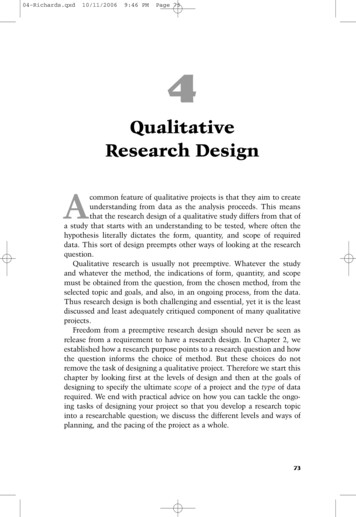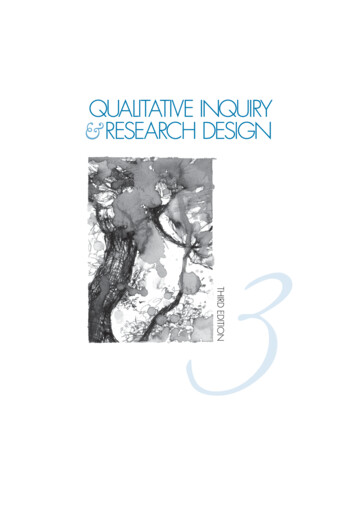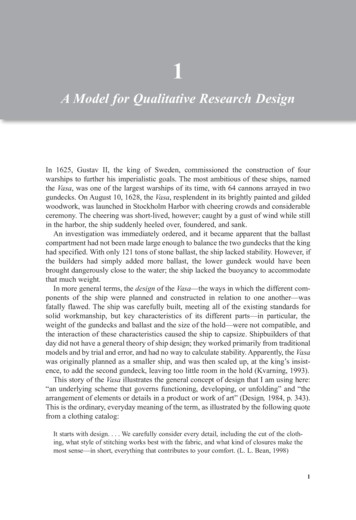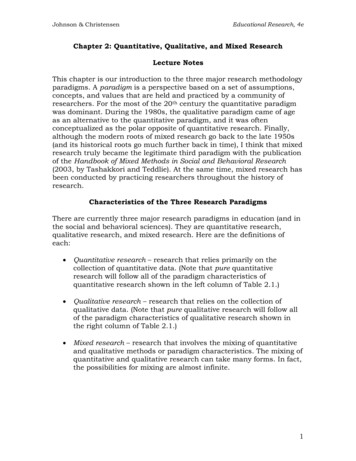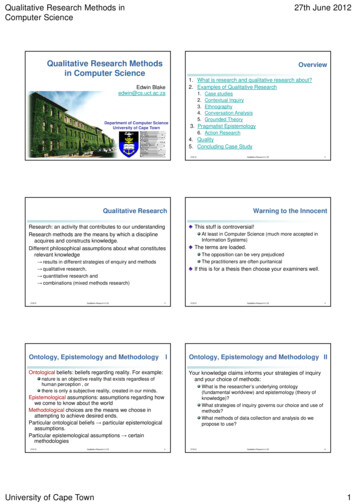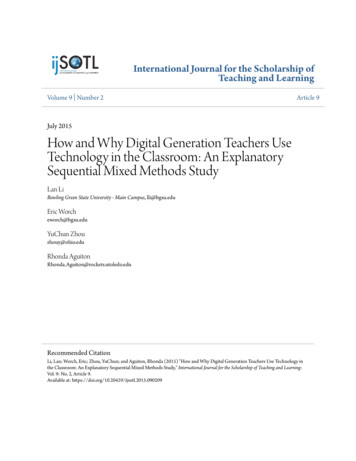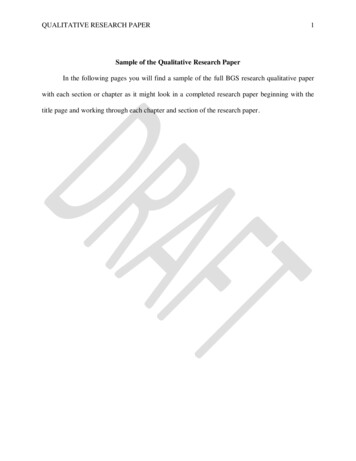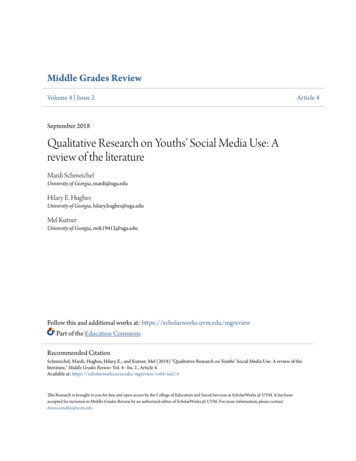
Transcription
Qualitative Researchfrom Start to Finish
Qualitative Researchfrom Start to FinishS e c o n dE d i t i o nRobert K. YinTHE GUILFORD PRESSNew York London
2016 The Guilford PressA Division of Guilford Publications, Inc.370 Seventh Avenue, Suite 1200, New York, NY 10001www.guilford.comAll rights reservedNo part of this book may be reproduced, translated, stored in a retrievalsystem, or transmitted, in any form or by any means, electronic, mechanical,photocopying, microfilming, recording, or otherwise, without writtenpermission from the publisher.Printed in the United States of AmericaThis book is printed on acid-free paper.Last digit is print number:987654321Library of Congress Cataloging-in-Publication DataYin, Robert K.Qualitative research from start to finish / Robert K. Yin.—Second Edition.pages cmIncludes bibliographical references and index.ISBN 978-1-4625-1797-8 (pbk.)—ISBN 978-1-4625-2134-0 (hardcover)1. Qualitative research. 2. Research—Methodology. 3. Social sciences—Research. I. Title.H62.Y57 2015001.4′2—dc232014047826
To Karen and Andrew,for many years of love, devotion, and tolerance,and for being willing to entertain the possibility thatsocial science can be a lifelong and stimulating endeavor
PrefaceThis book presents a comprehensive introduction to qualitative research. Yourinterest may ref lect a desire to do it, to teach it, or just to learn about it. In anyof these situations, the book can help. The goal is to know how to practicequalitative research—at a high level.The book embraces all the major phases of qualitative research, from starting a study to collecting and analyzing data to interpreting findings and drawing conclusions. Each phase is illustrated with a wide array of published studies(including some of the classics and many of the exciting contemporary ones).The idea is to explain key concepts and procedures in the context of successfully implemented works, showing how previous scholars have mastered theinevitable challenges.The combination of a complete and detailed scope (i.e., from “start to finish”), based on a strong foundation of previously published studies, may not bereadily found elsewhere. You will gain important knowledge about qualitativeresearch, and you will see for yourself specific examples of how it has come ofage as part of the social science mainstream.The Book’s Three ThemesThe book has three themes: being practical, inductive, and adaptive. Thesethemes may sound as if they could be related to virtually any endeavor. However, they are especially well tuned to the nonformulaic nature of qualitativeresearch.For example, how to analyze qualitative data continues to be one of themost challenging tasks in doing qualitative research. As one result, some textsvii
viiiPrefacehave paid increasing attention to the mechanics of coding qualitative data—butthis only represents half the job. The more difficult half comes after any codinghas been done, calling for you to know how to look for patterns, to interpretfindings, and to draw conclusions. As a result, Chapters 8 and 9 of this book(see Reassembling, Interpreting, and Concluding) walk you through these processesin considerable detail (the practical theme) by showing you how these taskswere accomplished in successfully published studies (the inductive theme), whileexposing you to a variety of options (the adaptive theme). Let’s look at the threethemes a bit more closely.A Practical ApproachAs its main theme, the book presents qualitative research from a practical perspective. Such a view reveals insights into how qualitative research is done at theground level. The approach should be especially useful if in fact you are actuallywanting to conduct a qualitative study—whether it is to be self-standing, partof a larger study, or an academic or training assignment for an undergraduate,graduate, or continuing education course.The practical perspective means giving explicit attention to a wide range ofprocedures ranging from how to start a new qualitative research study (Chapter 3) to doing fieldwork and collecting data (Chapters 5 and 6) to displayingand composing the final results of a study (Chapters 10 and 11). Throughout,the text contains many citations to other methodological works (not just otherqualitative studies), enabling you to delve more deeply into any given procedure. For example, the discussion on collecting qualitative data gives you leadsto other specialized works for doing qualitative interviews, making field observations, examining documents and artifacts, and the like.An Inductive ApproachUsing an inductive approach, the second theme, the book presents numerousexamples of successfully completed and published qualitative studies. Thesestudies cover many different academic disciplines and professions, such as sociology, anthropology, psychology, education, public health, social work, community development, evaluation, business, and international affairs. The examples typically take the form of either vignettes or shaded inserts, and are strewnthroughout the book. Both provide more insight into individual studies thanthe standard citations commonly found elsewhere. Moreover, the materials inthe vignettes and shaded inserts come from widely available journals and books.Their ready availability enables you to inspect these materials in greater detail,if you wish.By providing a concrete understanding of how qualitative research hasbeen done by different scholars, the numerous examples convey the breadth ofqualitative research. The topics extend over many social and everyday settings,also covering important substantive strands in qualitative research, such as
Prefacestudies relating to feminist issues, gender, race and ethnicity, family and work,and social justice. As a most important characteristic, all the illustrative studiesare completed ones. As such, they should boost your confidence in being ableto finish (and publish) your own qualitative research.Similarly, two completed studies, and how they were conducted in relationto the material in Chapters 8, 9, and 12, are presented as Sample Studies 1 and 2at the end of those chapters. The studies examine two topics intended to appealto all readers because everyone has experienced the two environments (K–12education in one case and postsecondary administration in the other).An Adaptive ApproachThe third theme deliberately presents qualitative research in an adaptive fashion. Rather than conveying such research in a dogmatic, much less ideologicalmanner, the book repeatedly dissects critical methodological procedures—suchas how to design or analyze qualitative research—and presents the steps in theform of optional choices. These choices will enable you to customize your ownqualitative study.For instance, you can create your own design, based on eight choices presented in Chapter 4. The result can be a qualitative study that will range fromthe traditional way of doing qualitative research (i.e., without giving muchattention to formal design) to a more pragmatic approach that takes advantageof one or more of the current design techniques and tools. Similarly, you havethe choice of starting fieldwork before finalizing your research questions—anoption examined in Chapter 3. You also can decide whether or not to codeyour data and whether or not to use computer software to assist in analyzingyour data, as discussed in Chapters 8 and 9. If you have trouble starting a qualitative study in the first place, the ideas in Chapter 3 about creating a study bankalso offer insightful options.What’s Differentabout This Second Edition?On the surface, little may seem changed: The book still has the same 12 chapters, and a brief perusal of the table of contents shows that most of the majorheadings and exhibits appear to be the same as before. However, beneath thesurface exist significant changes, in part based on colleagues’ feedback aboutthe first edition (2011) and their experiences in using it. The goal for this second edition was to preserve the book’s original structure (presumably easingthe use of the new edition by adopters of the first edition) but to respond tothe feedback with enhancements—and hopefully make the book more useful.The most important enhancements are signaled by the several headingsthat are either new or different. First, one of the most appealing features ofix
xPrefacequalitative research is its ability to attract researchers who may have contrastingworldviews about the purpose of empirical research and how such research mightbest get done. Compared to the first edition, Chapter 1 of the second editionprovides a stronger rendition of the differences in worldviews and their roots,as well as of the options available, such as the constructivist, postpositivist, and pragmatic approaches (see “Qualitative Research and Its Belief Systems,” in Chapter1). In addition to the material in Chapter 1, the rest of the book calls attentionto how worldview differences might entail different methodological preferences. For instance, a new discussion distinguishes between seeking trustworthiness, compared to validity, in boosting the credibility of qualitative research (seeChoice 2, “Taking Steps to Strengthen the Credibility of a Study [or Not],” inChapter 4). Likewise, new text covers both generalizability and transferability asdifferent ways of extending a qualitative study’s findings to other situations thatwere not part of the original study (see Choice 6, “Being Concerned with theGeneralizability or Transferability of a Study’s Findings [or Not],” in Chapter4).Second, the book gives more attention to the possibility of adopting oneof 12 specialized types (or variants or genres) of qualitative research. The bulk ofthis book still favors a more generalized form of qualitative research—under therubric of doing a “field study” or doing a “qualitative study” rather than usingany more specific label—and avoids the need to deal with any of the types.Chapter 3 (see “Revealing the Multifaceted World of Qualitative Research”)nevertheless discusses the specialized types and highlights the importance ofseeking supplementary guidance if readers want to adopt one of the types as anadjunct to the more generalized form of qualitative research. To get a start inobtaining such guidance, Chapter 3 (see Exhibit 3.4) then identifies a variety ofkey sources related to each of the specialized types.Yet a third significant enhancement deals with the analysis of qualitative data,in part f lagged by new subheadings in Chapters 8 and 9. The two chapters stillpresent five analytic cycles, as in the first edition. However, the first editionassumed that researchers could just glide from one cycle to another. In fact, inactual practice the cycle-to-cycle transitions can be troublesome, with repeatedrisks to the researcher of getting stalled and not knowing where or how to startthe next analytic cycle. The text under these new subheadings offers additionalideas for making the transitions, such as disassembling data but then gettingrestarted by looking for patterns when trying to reassemble the data. As mentioned earlier in this preface, the book pays considerable attention to the challenge of finding patterns that can sustain an analytic f low, and much rewritingin Chapter 8 also has hopefully made the original ideas clearer.Fourth, the book has a much expanded discussion of mixed methods research(see Chapter 12). Qualitative components have been extremely importantto mixed methods designs. In turn, the designs have helped to provide newinsights into qualitative findings. Doing mixed methods studies may thereforebe an important way of extending the continuing reach of qualitative research,
Prefaceso the chapter offers a much enriched portal into the relevant methods and literature than does the first edition.Finally, the new edition has reinforced or expanded many other topics,such as new or enhanced discussions of (1) research as a craft (Chapter 1); (2)acknowledging one’s research lens (a new small section in Chapter 2 guides readers to several other places in the book that discuss the research lens); (3) a moreextended discussion of different kinds of study samples in designing a qualitative study; and (4) another way of concluding a qualitative study—by takingaction—in recognition of qualitative researchers’ increasingly proactive stancesin the real world (see “Concluding by Taking Action,” in Chapter 9).Overall, the second edition’s closer look at these and other topics hasresulted in numerous additional citations as well as an expanded glossary ofterms related to qualitative research. For instance, the additional citations haveresulted in a reference section with over 30% more references than in the previous edition. Moreover, many of the original references have been updated. Allthis extra documentation will hopefully enable readers to become even betterversed about qualitative research than before.How the Book Engages ReadersSeveral additional features are intended to stimulate your active involvementwith the book. All are holdovers from the first edition. First, all the chaptersstart with a brief introduction, overviewing the contents of each chapter. Then,each of the sections within each chapter starts with a preview box, brief ly covering what you should learn from this section. Finally, every chapter features arecap of the terms and concepts presented in the chapter.Second, each chapter ends with an exercise ref lecting the ideas covered bythe chapter. The exercises are intended to serve as out-of-class assignmentsthat can be done on a weekly basis. As an alternative, Appendix C contains acomprehensive, semester- or year-long project that can be done in lieu of (or inaddition to) the individual exercises.Third, the second edition has augmented the citation to the key terms andconcepts that appear in the recap at the end of each chapter. Those terms andconcepts now appear in boldface in the text of the chapter, enabling you to findthem more quickly and to see how the text actually used them. In addition,many more terms and concepts have now been highlighted. Reviewing themas part of a recap then becomes another way for you to know whether you haveabsorbed the gist of a chapter.As before, the back of the book contains another feature, whereby theeditors at The Guilford Press permitted one discretionary stretching of thestandard American Psychological Association format: The reference sectionincludes the authors’ first names, not just their initials. Knowing the first namesxi
xiiPrefaceclearly reduces confusion among persons who might have the same surnameas well as similar initials. However, more important as a contextual part of thequalitative research experience, such knowledge also might help you to connectthe cited authors with real-life people—some of whom might even be teachingor have taught at an academic department related to you.The spirit of the book’s working features remains the same. Books such asthe present one do not replace actual research studies and the richness of theirfindings and deeper meanings. Instead, good texts should provide two things:practical knowledge that can impact immediately on the pursuit of a researchendeavor, and clues in the form of citations where you can learn more about atopic and its field. So it is with the present text.
AcknowledgmentsMy research experience covers work done at several different research and academic organizations. Within each organization key colleagues have contributed to my thinking about qualitative research, and I would like to express myindebtedness to them. These colleagues situated themselves according to theirown distinctive specializations, not necessarily knowing that, along the way, Iwas a beneficiary of their collective wisdom.At MIT, I studied under Professor Hans-Lukas Teuber. Given his sensitivity to Gestalt psychology (surprising for a neurophysiologist), I chose to focuson face recognition. Although the research used methods from experimentalpsychology, the main research question—how people easily recognize and discriminate an extremely large number of faces despite their similarity accordingto any objective measure—still in my mind represents a qualitative question ofthe first order.Later at MIT, but now in the Department of Urban Studies and Planning,I also had the pleasure of knowing Lawrence Susskind and Lloyd Rodwin,both of whom strongly encouraged my work on neighborhood development.That area of inquiry involved a diversity of research methods, ranging from theanthropological to the demographic.Work at the New York City–Rand Institute and at the Rand Corporation’s office in Washington, D.C., pushed me further into the study of urbanand related policy topics. Peter Szanton made his mark on my thinking throughhis incessant questioning and sage advice on how to make research relevant anduseful. Similarly, a stint at American University’s School of International Service, guided by Professor Nanette Levinson, led to a broader appreciation forresearch on international development.xiii
xivAcknowledgmentsThrough these years, the greatest effort has been associated with COSMOSCorporation—an independent research organization devoted to the examination of contemporary social issues. COSMOS’s research projects have beensupported by public agencies and private foundations alike. The firm’s numerous clients, especially Bernice Anderson at the National Science Foundation,have their own published work and have created their own brand of stimulating ideas and critical feedback. The key topics of discussion, if not contention, always have tended to be methodological ones. And the more challengingmethodological issues always seem to be the qualitative ones.Over the same years, I have gained a broader perspective through collaborative teaching with scholars overseas, particularly in Denmark, France, andThe Netherlands. For instance, one engagement involved two separate cohortsof doctoral students led by Professor Iben Nathan at the University of Copenhagen. Domestically, I have worked with doctoral classes at Case Western University and at Southern New Hampshire University.Most recently, my COSMOS work has led to a significant amount of timebeing spent with colleagues doing evaluation research at the United Nationsand service delivery research and evaluation at the World Bank. Together,we have had to develop rigorous but cost-conscious ways of doing qualitative research on a broad variety of international topics. At the United Nations,Sukai Prom-Jackson and Fabrizio Felloni have been primary collaborators andhave sensitized me to the variety of challenges involved in doing such research.At the World Bank, Christos Kostopoulos, Vera Wilhelm, Sameh El-Saharty,Erica Chiajui Wu, Susan Cáceres, Pia Schneider, Xubei Luo, Giuseppe Iarossi,Erik Bloom, and Mark Sundberg have guided me through the issues and introduced me to other specialists trying to improve the relevance of qualitativeresearch and evaluation in country-specific venues. You can imagine the disparate conditions created by such different contexts, helping again to appreciatethe fundamental value of qualitative research.The preparation of this book has benefited from a more immediate set ofcritical friends. They include seven reviewers of an early draft of the first edition: Jessie L. Kreinert (Criminal Justice, Illinois State University); Penny Burge(Education, Virginia Tech); James A. Holstein (Social and Cultural Sciences,Marquette University); Michelle Bligh (School of Behavioral and Organizational Sciences, Claremont Graduate University); Lance Fusarelli (EducationLeadership, North Carolina State University); Thalia Mulvihill (Education,Ball State University); and Susan Shepler (School of Business, American University). Two of these reviewers (Bligh and Fusarelli) then bravely agreed to beamong a second set of reviewers of the published version of the first edition,as prelude to this new edition. The second set also included Brandi Lawless(Communications, University of San Francisco); Miriam Levitt (Political Science, University of Ottawa); Barbara Patterson (Nursing, Widener University);Regina T. P. Aguirre (Social Work, University of Texas, Arlington); and PennyA. Pasque (Women and Gender Studies, University of Oklahoma).
AcknowledgmentsYou reviewers all have kindly offered helpful written suggestions and commentary, identifying gaps to be filled and ways of resequencing and restructuring chapters. For these ideas I will be forever grateful. If I’m lucky, you mightsee most (but, granted, not necessarily all) of your comments ref lected in thisfinal version of the second edition.Numerous words of encouragement and advice came from a distinguishedcritical friend, C. Deborah Laughton (Guilford’s Publisher, Methodology andStatistics), whose experience in publishing qualitative and other research methods texts probably goes further back than she would want to acknowledge. Ourlongstanding acquaintance served as an invaluable presence in providing inspiration to start and complete both the first and second editions. I am extremelyappreciative for having such a supportive relationship.Finally, during the writing of both editions, my wife, Karen, and son,Andrew, had to tolerate the book’s continued distraction to our family life,over a lengthy period of time. They gave their unconditional love, interspersedwith compositional creativity in helping to find better words and sharper andshorter sentences. The dedication of this book to them is but a small way ofacknowledging their enduring support, though Karen fell ill and passed awayjust as work on the second edition was getting started.All these interactions notwithstanding, none of the named institutions orindividuals bears any responsibility for the final product or for the statements inthis book, which remains my responsibility alone.These acknowledgments would nevertheless be incomplete without a fewmore sentences about my own research lens and how it might have inf luencedthe shaping of this book. Its three main themes ref lect a career built around having done research projects on a wide variety of topics. The projects have typically been conducted in conjunction with colleagues at COSMOS, and beingpractical, inductive, and adaptive has served us well in bringing these projectsto successful conclusions. By arriving at each project’s concluding step—anacademic publication or a final report of some sort—we all have practiced theentire research cycle many times (and again, from start to finish).At the same time, this book also makes more than an occasional referenceto parallels or contrasts with other types of social science research, includingmy own work on case study research. Although this book highlights qualitativeresearch in all its depth and breadth, the references purposefully try to showcase the research as part of a larger world stage, beyond being a tent unto itsown. In this expansive sense, the allusions to nonqualitative research ref lect aconnectivity with my own training in experimental psychology. Similarly, thedescriptions of some of qualitative research’s classic works ref lect a connectivitywith my original training in the field of history, including historiography—history’s longstanding way of acknowledging the unavoidable presence of aresearch lens.The career experiences underlie my attempt to have this book cover qualitative research comprehensively. The various chapters address virtually everyxv
xviAcknowledgmentsphase of doing qualitative research, including some topics that also tend to beunderplayed by other texts. For instance, nearly every qualitative study callsfor presenting the meaning of social reality from the perspective of a study’sparticipants (people whose lives are a large part of the subject of study). Yet,there are different ways of presenting their words or life histories, and this bookexplicitly identifies and offers you choices among these variations (see Chapter 10). As another example, most books do not discuss the various ways ofdrawing conclusions from qualitative research, but this book identifies at leastfive such ways (see Chapter 9). Finally, the breadth of fieldwork proceduresdescribed in Chapters 5 and 6 ref lects my own experiences in doing field-basedstudies, which in the past have relied on participant-observation, case studies,qualitative interviews, field photography, or site visits.You the reader will be the final arbiter of how well all this works. I welcome your comments about the book and will gladly dialogue with you aboutqualitative research. To start such a process, please feel free to contact me atrobertkyin@att.net.
Brief ContentsPa r t I Understanding Qualitative ResearchC h a p t e r 1 What Is Qualitative Research—and Why Might You Consider Doing Such Research?3C h a p t e r 2 Getting Ready to Do Qualitative Research27C h a p t e r 3 How to Start a Qualitative Research Study53Pa r t II Doing Qualitative ResearchC h a p t e r 4 Choices in Designing Qualitative Research Studies83C h a p t e r 5 Doing Fieldwork116C h a p t e r 6 Data Collection Methods137C h a p t e r 7 Recording Data163C h a p t e r 8 Analyzing Qualitative Data, I:184C h a p t e r 9 Analyzing Qualitative Data, II:218Compiling, Disassembling, and ReassemblingInterpreting and Concludingxvii
xviiiBrief ContentsPa r t III Presenting the Results from Qualitative ResearchC h a p t e r 10 Displaying Qualitative Data249C h a p t e r 11 Composing Research to Share It with Others271Pa r t I V Taking Qualitative Research One Step FurtherC h a p t e r 12 Broadening the Challenge of Doing297App e n d i x A Illustrative Study Bank321App e n d i x B Two Levels of Data Collection Units in Illustrative325App e n d i x C A Semester- or Year-Long Project: Career Paths329Qualitative ResearchQualitative Studies Cited in This BookA Glossary of Special Terms Usedin Qualitative Research333References343Author Index366Subject Index370About the Author386
Detailed ContentsPa r t I Understanding Qualitative ResearchC h a p t e r 1 What Is Qualitative Research—3and Why Might You Consider Doing Such Research?A. The Allure of Qualitative Research: A Topical Panoramaof Studies 3Vignette 1.1. A Qualitative Study of Homeless WomenB. The Distinctiveness of Qualitative ResearchQualitative Research: A Broad Area of Inquiry 7Five Features of Qualitative Research 847Vignette 1.2. Using Qualitative Research to Produce New Insights 10Vignette 1.3. Using an Overarching Concept to Organizea Qualitative Study 11Brief Preview of the Research Procedures Covered in the Restof This Book 11C. Qualitative Research as a CraftDoing Original Research 13Transparency 13Methodic‑ness 14Adherence to Evidence 1412D. Qualitative Research and Its Belief Systems 15The Nature of Reality (Whether Multiple or Singular) 16The Conduct of Research (Whether Value‑Free or Value‑Bound) 18The Quality of Research Findings (Whether Time‑ and Context‑Freeor Time‑ and Context‑Specific) 19Vignette 1.4. An Immersion Study of Physicians’ Training20Causal Relationships (Whether Causes and Effects Are Readily Discerned)Alternative Worldviews 2221Vignette 1.5. Fifteen Years of Ethnographyin the Ticuanense Community 24Illustrative Studies Offered in the Remainder of This Book24Vignette 1.6. Qualitative Research Addressing a MajorU.S. Policy Shift 25Recap for Chapter 1 26Exercise for Chapter 1 26xix
xxDetailed ContentsC h a p t e r 2 Getting Ready to Do Qualitative ResearchA. Personal Attributes in Doing Field‑Based Research 28“Listening” 28Asking Good Questions 29Knowing Your Topic of Study 30Caring about Your Data 31Doing Parallel Tasks 32Persevering 3227Vignette 2.1. Overcoming the Challenges of DoingIntensive, Field-Based Research 33B. Managing Field‑Based Research 33Vignette 2.2. A Qualitative Study Based Solelyon Open‑Ended Interviews 34Making Time to Think Ahead34Exhibit 2.1. Stephen Covey’s (1989) Time Management MatrixManaging Field Teams3536Vignette 2.3. Desirable Teamwork for a Study Basedon Open-Ended Interviews 36Vignette 2.4. Doing Fieldwork with Multiple PersonsWorking in Multiple Settings 37Vignette 2.5. Organizing a Research Team to CollectExtensive Field Data 38Practicing 38Using the Exercises in This Book to PracticeDoing a Pilot Study 39Getting Motivated 39C. Acknowledging Your Research Lens3840D. Setting and Maintaining Ethical Standards of Conduct 41An Illustrative Ethical Challenge: Fairly Examining All of Your DataCodes of Ethics 4342Exhibit 2.2. Illustrative Items in Codes of Ethics of SixProfessional Associations 43Research Integrity 44Disclosure as One Way of Demonstrating Research Integrity45Vignette 2.6. Detailing the Methodological Choicesand Personal Conditions in Doing a Qualitative StudyVignette 2.7. Doing Qualitative Research and Advocatinga Sociopolitical Cause 4645E. Protecting Human Subjects: Obtaining Approvalfrom an Institutional Review Board 47Submitting Study Protocols for Review and Approval 48Specific Considerations in Protecting Human Subjects 49Preparing for IRB Review 50The Informed Consent Dialogue (in the Field) as an Opportunityfor Participants to Query You 51Recap for Chapter 2 52Exercise for Chapter 2 52C h a p t e r 3 How to Start a Qualitative Research StudyA. The Challenge of Starting an Empirical Study 54Three Goals for Successfully Starting Up 55Ways of Getting Started 5553
Detailed ContentsxxiB. Developing a Study Bank 56Results from Creating an Illustrative Study Bank 56Exhibit 3.1. Journals Searched to Identify Qualitative Studiesfor the Study Bank in Appendix A 571. Identifying a Topic of Inquiry57Exhibit 3.2. Topics Covered by Illustrative Studies Citedin the Study Bank in Appendix A 582. Identifying a Data Collection Method60Vignette 3.1. An Interview Study Leading to a Policy Agenda 61Exhibit 3.3. Multiple Sources of Da
qualitative research—at a high level. The book embraces all the major phases of qualitative research, from start - ing a study to collecting and analyzing data to interpreting findings and draw-ing conclusions. Each ph


